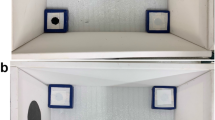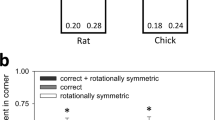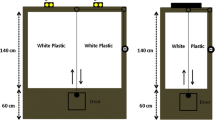Abstract
Although geometric reorientation has been extensively studied in numerous species, most research has been conducted in enclosed environments and has focused on use of the geometric property of relative wall length. The current studies investigated how angular information is used by adult humans and pigeons to orient and find a goal in enclosures or arrays that did not provide relative wall length information. In enclosed conditions, the angles formed a diamond shape connected by walls, whereas in array conditions, free-standing angles defined the diamond shape. Adult humans and pigeons were trained to locate two geometrically equivalent corners, either the 60° or 120° angles. Blue feature panels were located in the goal corners so that participants could use either the features or the local angular information to orient. Subsequent tests in manipulated environments isolated the individual cues from training or placed them in conflict with one another. In both enclosed and array environments, humans and pigeons were able to orient when either the angles or the features from training were removed. On conflict tests, female, but not male, adult humans weighted features more heavily than angular geometry. For pigeons, angles were weighted more heavily than features for birds that were trained to go to acute corners, but no difference in weighting was seen for birds trained to go to obtuse corners. These conflict test results were not affected by environment type. A subsequent test with pigeons ruled out an interpretation based on exclusive use of a principal axis rather than angle. Overall, the results indicate that, for both adult humans and pigeons, angular amplitude is a salient orientation cue in both enclosures and arrays of free-standing angles.








Similar content being viewed by others
References
Andersen NE, Dahmani L, Konishi K, Bohbot VD (2012) Eye tracking, strategies, and sex differences in virtual navigation. Neurobiol Learn Mem 97:81–89. doi:10.1016/j.nlm.2011.09.007
Astur RS, Ortiz ML, Sutherland RJ (1998) A characterization of performance by men and women in a virtual Morris water task: a large and reliable sex difference. Behav Brain Res 93:185–190. doi:10.1016/S0166-4328(98)00019-9
Bodily KD, Eastman CK, Sturz BR (2011) Neither by global nor local cues alone: evidence for a unified orientation process. Anim Cogn 14:665–674. doi:10.1007/s10071-011-0401-x
Cheng K (1986) A purely geometric module in the rat’s spatial representation. Cognition 23:149–178. doi:10.1016/0010-0277(86)90041-7
Cheng K (2005) Reflections on geometry and navigation. Connect Sci 17:5–21. doi:10.1080/09540090500138077
Cheng K, Newcombe NS (2005) Is there a geometric module for spatial orientation? Squaring theory and evidence. Psychon B Rev 12:1–23. doi:10.3758/BF03196346
Chiandetti C, Vallortigara G (2010) Animals’ representation of enclosed spaces: evidence for use of a similar frame of reference following different disorientation procedures in the domestic chick (Gallus gallus). J Comp Psychol 124:139–146. doi:10.1037/a0017013
Doeller CF, King JA, Burgess N (2008) Parallel striatal and hippocampal systems for landmarks and boundaries in spatial memory. P Natl Acad Sci USA 105:5915–5920. doi:10.1073/pnas.0801489105
Eals M, Silverman I (1994) The hunter-gatherer theory of spatial sex differences: proximate factors mediating the female advantage in recall of object arrays. Ethol Sociobiol 15:95–105. doi:10.1016/0162-3095(94)90020-5
Gibson BM, Wilks TJ, Kelly DM (2007) Rats (Rattus norvegicus) encode the shape of an array of discrete objects. J Comp Psychol 121:130–144. doi:10.1037/0735-7036.121.2.130
Gouteux S, Spelke ES (2001) Children’s use of geometry and landmarks to reorient in an open space. Cognition 81:119–148. doi:10.1016/S0010-0277(01)00128-7
Graham M, Good MA, McGregor A, Pearce JM (2006) Spatial learning based on the shape of the environment is influenced by properties of the objects forming the shape. J Exp Psychol Anim B 32:44–59. doi:10.1037/0097-7403.32.1.44
Gray ER, Bloomfield LL, Ferrey A, Spetch ML, Sturdy CB (2005) Spatial encoding in mountain chickadees: features overshadow geometry. Biol Lett 1:314–317. doi:10.1098/rsbl.2005.0347
Hermer L, Spelke ES (1994) A geometric process for spatial reorientation in young children. Nature 370:57–59. doi:10.1038/370057a0
Horne MR, Pearce JM (2011) Potentiation and overshadowing between landmarks and environmental geometric cues. Learn Behav 39:371–382. doi:10.3758/s13420-011-0032-8
Hupbach A, Nadel L (2005) Reorientation in a rhombic environment: no evidence for an encapsulated geometric module. Cogn Dev 20:279–302. doi:10.1016/j.cogdev.2005.04.003
Kelly D (2010) Features enhance the encoding of geometry. Anim Cogn 13:453–462. doi:10.1007/s10071-009-0296-y
Kelly D, Bischof WF (2005) Reorienting in images of a three-dimensional environment. J Exp Psychol Hum 31:1391–1403. doi:10.1037/0096-1523.31.6.1391
Kelly D, Bischof WF (2008) Orienting in virtual environments: how are surface features and environmental geometry weighted in an orientation task? Cognition 109:89–104. doi:10.1016/j.cognition.2008.07.012
Kelly DM, Gibson BM (2007) Spatial navigation: orienting in real and virtual environments. Comp Cogn Behav Rev 2:111–124. Retrieved from http://psyc.queensu.ca/ccbr/
Learmonth AE, Nadel L, Newcombe NS (2002) Children’s use of landmarks: implications for modularity theory. Psychol Sci 13:337–341. doi:10.1111/14679280.00461
Learmonth AE, Newcombe NS, Sheridan N, Jones M (2008) Why size counts: children’s spatial reorientation in large and small enclosures. Dev Sci 11:414–426. doi:10.1111/j.1467-7687.2008.00686.x
Lee SA, Spelke ES (2010) A modular geometric mechanism for reorientation in children. Cogn Psychol 61:152–176. doi:10.1016/j.cogpsych.2010.04.002
Lee SA, Sovrano VA, Spelke ES (2012) Navigation as a source of geometric knowledge: young children’s use of length, angle, distance, and direction in a reorientation task. Cognition 123:144–161. doi:10.1016/j.cognition.2011.12.015
Lever C, Wills T, Cacucci F, Burgess N, O’Keefe J (2002) Long-term plasticity in hippocampal place-cell representation of environmental geometry. Nature 416:90–94. doi:10.1038/416090a
Lew AR (2011) Looking beyond the boundaries: time to put landmarks back on the cognitive map? Psychol Bull 137:484–507. doi:10.1037/a0022315
Lourenco SF, Addy D, Huttenlocher J, Fabian L (2011) Early sex differences in weighting geometric cues. Dev Sci 14:1365–1378. doi:10.1111/j.1467-7687.2011.01086.x
Lubyk DM, Spetch ML (2012) Finding the best angle: pigeons (Columba livia) weight angular information more heavily than relative wall length in an open-field geometry task. Anim Cogn 15:305–312. doi:10.1007/s10071-011-0454-x
Lubyk DM, Dupuis B, Gutiérrez L, Spetch ML (2012) Geometric orientation by humans: angles weigh in. Psychon B Rev 19:436–442. doi:10.3758/s13423-012-0232-z
MacFadden A, Elias L, Saucier D (2003) Males and females scan maps similarly, but give directions differently. Brain Cogn 53:297–300. doi:10.1016/S0278-2626(03)001301
Newcombe NS, Ratliff KR, Shallcross WL, Twyman AD (2010) Young children’s use of features to reorient is more than just associative: further evidence against a modular view of spatial processing. Dev Sci 13:213–220. doi:10.1111/j.14677687.2009.00877.x
Pearce JM, Good MA, Jones PM, McGregor A (2004) Transfer of spatial behavior between different environments: implications for theories of spatial learning and for the role of the hippocampus in spatial learning. J Exp Psychol Anim B 30:135–147. doi:10.1037/0097-7403.30.2.135
Pecchia T, Vallortigara G (2010) Reorienting strategies in a rectangular array of landmarks by domestic chicks (Gallus gallus). J Comp Psychol 124:147–158. doi:10.1037/a0019145
Pecchia T, Vallortigara G (2012) Spatial reorientation by geometry with freestanding objects and extended surfaces: a unifying view. PR Soc B 279:2228–2236. doi:10.1098/rspb.2011.2522
Ratliff KR, Newcombe NS (2007) A matter of trust: when landmarks and geometry are used during reorientation. In: McNamara DS, Trafton JG (eds) Proceedings of the 29th annual cognitive science society. Austin, TX
Reichert JF, Kelly DM (2011) Use of local and global geometry from object arrays by adult humans. Behav Process 86:196–205. doi:10.1016/j.beproc.2010.11.008
Reichert JF, Kelly DM (2012) Discrimination of geometric angles by adult humans. Anim Cogn 15:271–284. doi:10.1007/s10071-011-0452-z
Saucier D, Bowman M, Elias L (2003) Sex differences in the effect of articulatory or spatial dual-task interference during navigation. Brain Cogn 53:346–350. doi:10.1016/S0278-2626(03)00140-4
Spelke ES, Lee SA, Izard V (2010) Beyond core knowledge: natural geometry. Cogn Sci 34:863–884. doi:10.1111/j.1551-6709.2010.01110.x
Spetch ML, Cheng K, MacDonald SE, Linkenhoker BA, Kelly DM, Doerkson SR (1997) Use of landmark configuration in pigeons and humans: II. Generality across search tasks. J Comp Psychol 111:14–24. doi:10.1037/0735-7036.111.1.14
Sturz BR, Bodily KD (2011) Is surface-based orientation influenced by a proportional relationship of shape parameters? Psychon B Rev 18:848–854. doi:10.3758/s13423-011-0111-z
Sturz BR, Forloines MR, Bodily KD (2012) Enclosure size and the use of local and global geometric cues for reorientation. Psychon B Rev 19:270–276. doi:10.3758/s13423-011-0195-5
Sutton JE (2009) What is geometric information and how do animals use it? Behav Process 80:339–343. doi:10.1016/j.beproc.2008.11.007
Sutton JE, Twyman AD, Joanisse MF, Newcombe NS (2012) Geometry three ways: an fMRI investigation of geometric information processing during reorientation. J Exp Psychol Learn 38:1530–1541. doi:10.1037/a0028456
Tommasi L, Polli C (2004) Representation of two geometric features of the environment in the domestic chick (Gallus gallus). Anim Cogn 7:53–59. doi:10.1007/s10071-003-0182-y
Twyman A, Newcombe N (2010) Five reasons to doubt the existence of a geometric module. Cogn Sci 34:1315–1356. doi:10.1111/j.1551-6709.2009.01081.x
Twyman A, Friedman A, Spetch ML (2007) Penetrating the geometric module: catalyzing children’s use of landmarks. Dev Psychol 43:1523–1530. doi:10.1037/0012-1649.43.6.1523
Vallortigara G, Zanforlin M, Pasti G (1990) Geometric modules in animal’s spatial representation: a test with chicks. J Comp Psychol 104:248–254. doi:10.1037/0735-7036.104.3.248
Wang RF, Hermer L, Spelke ES (1999) Mechanisms of reorientation and object localization by children: a comparison with rats. Behav Neurosci 113:475–485. doi:10.1037/0735-7044.113.3.475
Acknowledgments
The authors would like to thank Nicole Savignac, May So, Pauline Kwong, and Keith Baldoz for assistance with data collection and scoring. We also thank Isaac Lank for assistance with constructing the apparatus and Taylor Murphy for help with programming. This study was funded by individual Natural Sciences and Engineering Research Council of Canada Discovery grants awarded to MLS and WM. Animal research was conducted in accordance with Canadian Council on Animal Care guidelines and with approval from the University of Alberta Animal Welfare Policy Committee. Human research was conducted in accordance to the University of Alberta research ethics for human experiments.
Author information
Authors and Affiliations
Corresponding author
Rights and permissions
About this article
Cite this article
Lubyk, D.M., Spetch, M.L., Zhou, R. et al. Reorientation in diamond-shaped environments: encoding of features and angles in enclosures versus arrays by adult humans and pigeons (Columbia livia). Anim Cogn 16, 565–581 (2013). https://doi.org/10.1007/s10071-012-0594-7
Received:
Revised:
Accepted:
Published:
Issue Date:
DOI: https://doi.org/10.1007/s10071-012-0594-7




